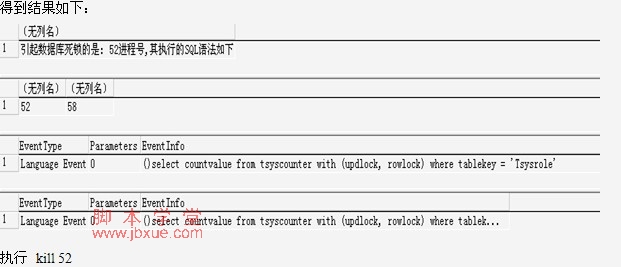在使用sql server数据库时,难免会产生死锁, 死锁出现以后,维护人员或者开发人员大多只会通过sp_who来查找死锁的进程,然后用sp_kill杀掉。
利用sp_who_lock这个存储过程,可以很方便的知道哪个进程出现了死锁,出现死锁的问题在哪里。
1、创建sp_who_lock存储过程:
复制代码 代码示例:
--proc
CREATE procedure sp_who_lock
as
begin
declare @spid int
declare @blk int
declare @count int
declare @index int
declare @lock tinyint
set @lock=0
create table #temp_who_lock
(
id int identity(1,1),
spid int,
blk int
)
if @@error<>0 return @@error
insert into #temp_who_lock(spid,blk)
select 0 ,blocked
from (select * from master..sysprocesses where blocked>0)a
where not exists(select * from master..sysprocesses where a.blocked =spid and blocked>0)
union select spid,blocked from master..sysprocesses where blocked>0
if @@error<>0 return @@error
select @count=count(*),@index=1 from #temp_who_lock
if @@error<>0 return @@error
if @count=0
begin
select '没有阻塞和死锁信息'
return 0
end
while @index<=@count
begin
if exists(select 1 from #temp_who_lock a where id>@index and exists(select 1 from #temp_who_lock where id<=@index and a.blk=spid))
begin
set @lock=1
select @spid=spid,@blk=blk from #temp_who_lock where id=@index
select '引起数据库死锁的是: '+ CAST(@spid AS VARCHAR(10)) + '进程号,其执行的SQL语法如下'
select @spid, @blk
dbcc inputbuffer(@spid)
dbcc inputbuffer(@blk)
end
set @index=@index+1
end
if @lock=0
begin
set @index=1
while @index<=@count
begin
select @spid=spid,@blk=blk from #temp_who_lock where id=@index
if @spid=0
select '引起阻塞的是:'+cast(@blk as varchar(10))+ '进程号,其执行的SQL语法如下'
else
select '进程号SPID:'+ CAST(@spid AS VARCHAR(10))+ '被' + '进程号SPID:'+ CAST(@blk AS VARCHAR(10)) +'阻塞,其当前进程执行的SQL语法如下'
dbcc inputbuffer(@spid)
dbcc inputbuffer(@blk)
set @index=@index+1
end
end
drop table #temp_who_lock
return 0
end
GO
在查询分析器中执行:
复制代码 代码示例:
exec sp_who_lock
查询结果:
